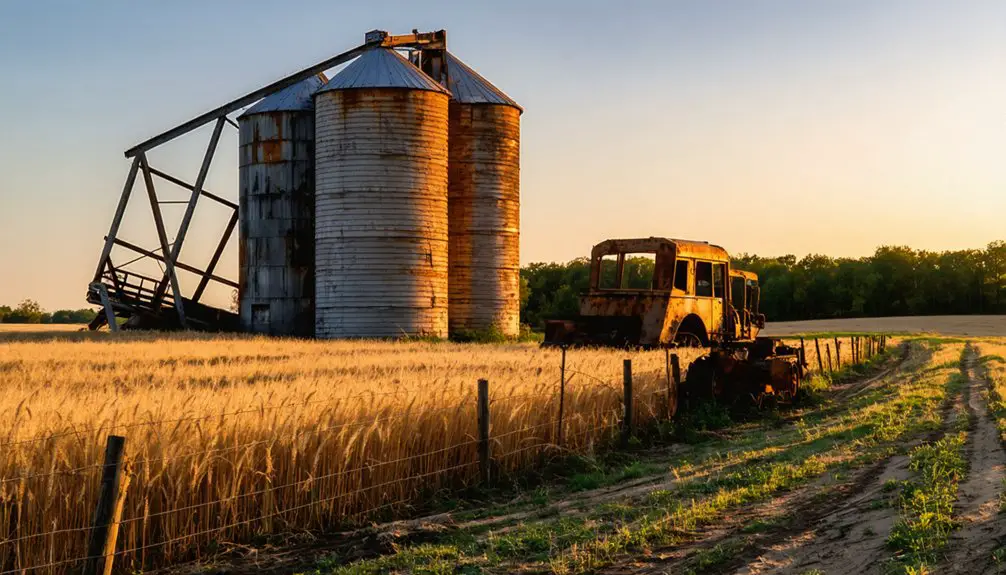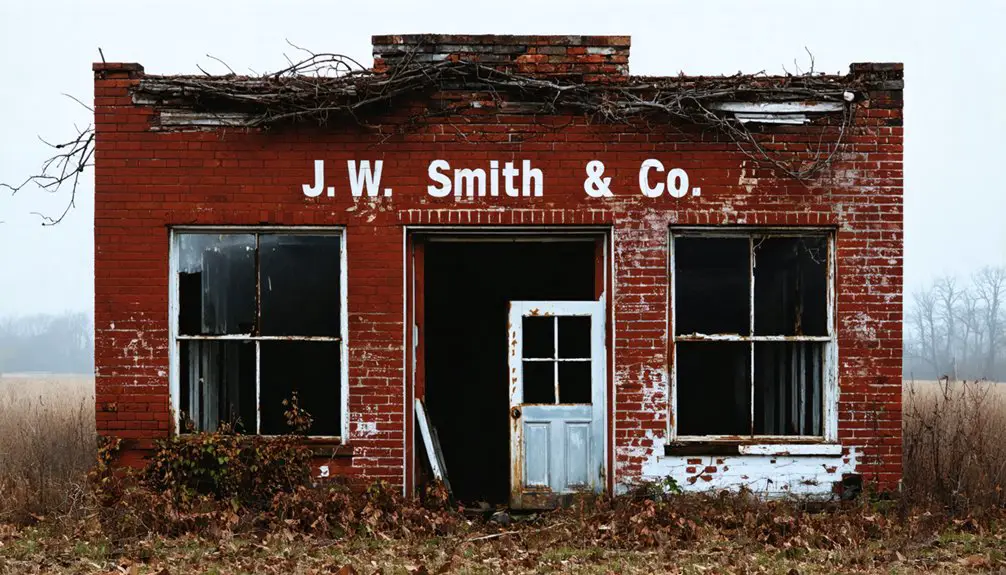You’ll find Omard’s ghost town remnants at the intersection of Peck and Isles Roads in Flynn Township, Sanilac County. This once-thriving agricultural community emerged in the 1860s, featuring a schoolhouse, post office (established 1871), and country store. After the post office closed in 1904, Omard gradually declined. Today, you can explore the empty general store, visit the still-active Methodist Episcopal Church, and discover the stories preserved in the adjacent cemetery’s weathered stones.
Key Takeaways
- Omard, Michigan emerged in the 1860s as an agricultural community at Peck and Isles Roads in Flynn Township, Sanilac County.
- The community’s decline began with the post office closure in 1904, followed by the schoolhouse demolition in the 1950s.
- Today, only the Methodist Episcopal Church, cemetery, and abandoned general store remain as physical remnants of Omard’s past.
- The town transformed from a bustling farming settlement into a ghost town after losing essential services and experiencing economic decline.
- Blattland Farms now operates on former schoolhouse land, while the site offers an authentic ghost town experience without tourism infrastructure.
The Birth of a Rural Settlement
As Michigan’s rural communities took shape in the 1860s, Omard emerged at the intersection of Peck and Isles Roads in Sanilac County’s Flynn Township.
The community origins traced back to essential rural infrastructure, beginning with the construction of the first schoolhouse between 1863 and 1869. You’d find early religious services being held in that same schoolhouse, demonstrating the resourceful spirit of pioneer settlers. While many Michigan settlements grew around narrow gauge railways, Omard developed independently as an agricultural community.
The establishment of a post office in 1871, housed within a local store, marked Omard’s growing importance as a service hub for surrounding farms. This postal service would remain active until mail was redirected to Brown City in 1904.
Unlike the boom-and-bust towns built around lumber or mining, Omard’s foundation rested on meeting the basic needs of local farming families through its general store, blacksmith shop, and postal services.
Early Community Life and Development
You’ll discover that Omard’s early community life centered around three key institutions established between 1863-1871: the schoolhouse that doubled as a church meeting place, the post office housed within Murray Blatt’s Store, and numerous family farms dotting the surrounding countryside.
Much like Amik’s population approaching 900 a century ago, Omard’s early years saw significant growth and development of community institutions before its decline.
The schoolhouse particularly shaped daily routines, serving as both an educational facility and social hub where agricultural families gathered for community events before dedicated venues existed.
The 1871 opening of the post office at the general store created a crucial communication link for farming families, who could now send and receive mail while conducting their regular trading activities in town.
Like many ghost towns in Michigan, Omard’s community structures stood as testament to the transient nature of rural settlements in the Upper Great Lakes region.
Post Office Hub Activity
While Omard’s early development centered around several key institutions, the post office established on April 25, 1871, proved crucial to the community’s growth and connectivity.
Similar to how Dr. Little’s cigar box served as Petoskey’s first mail container, Omard’s postal operations started with simple yet vital beginnings.
Located at the intersection of Peck and Isles Roads, the postal service operated from a store separate from the Omard Country Store, serving as a crucial communication hub until its closure in 1904.
You’d find this central gathering point bustling with community interaction as residents exchanged news and conducted business.
- The post office facilitated critical connections between rural families and the outside world
- Local farmers and merchants relied on postal services to maintain business relationships
- Community announcements and bulletins kept everyone informed of local happenings
- The post office’s presence marked Omard as a legitimate, established settlement
Schoolhouse Community Impact
The 1863 construction of Omard’s first schoolhouse marked a defining moment in the settlement’s evolution from scattered homesteads to an organized community.
You’ll find that this pioneering structure served far beyond its educational role, doubling as the town’s first church meeting house and social hub until 1896.
The schoolhouse significance extended deep into Omard’s development, with three successive buildings reflecting the community’s growth.
When the concrete block structure rose in 1904, it symbolized the town’s commitment to permanence and progress. Like Miss Ruth Sherman who in 1859 earned two dollars a week teaching at Centerville, early educators worked for modest wages.
Community gatherings, from public meetings to social events, centered around these schools.
Teachers, who often boarded locally, became influential community leaders.
This multifaceted institution fostered literacy, strengthened social bonds, and anchored the settlement’s identity through the early 1950s.
Agricultural Family Settlements
During the 1860s, pioneering families transformed Omard’s dense forestland into a vibrant agricultural community, clearing plots for subsistence farming and establishing homesteads across Sanilac County.
These early settler traditions included diverse farming techniques brought by German, British, Norwegian, Canadian, and Bohemian immigrants. You’d find families working together to plant potatoes, harvest corn, and produce maple syrup, while raising livestock for self-sufficiency. Local farmers received $2.00 per bushel for potatoes as market prices strengthened their economic stability. Like many agricultural communities of the era, they operated outside the scope of formal labor laws, which primarily focused on urban work forms.
- Farming was truly a family affair, with multiple generations sharing the daily responsibilities of maintaining their homesteads.
- Neighbor-to-neighbor cooperation created crucial support networks for tackling major farm tasks.
- The local general store and blacksmith shops provided essential supplies and equipment repairs.
- Mixed farming practices helped families adapt to Michigan’s unique climate and soil conditions.
Post Office Establishment and Operation
As Omard grew into a promising agricultural settlement in the late 19th century, local residents celebrated the establishment of their post office on April 25, 1871 – though some records suggest 1875.
The post office’s significance extended beyond just mail handling, serving as an essential hub for rural communication and community connection.
You’ll find it interesting that the post office wasn’t housed in the well-known Omard Country Store, but rather in a separate store building.
For over three decades, it served Flynn Township‘s farmers and residents until March 15, 1904, when services shifted to Brown City.
During its operation, you’d have found it bustling with locals exchanging news and conducting postal business.
The closure marked a turning point, as Omard’s identity began fading toward its eventual ghost town status.
Agricultural Heritage and Economy

While Omard’s post office served as a communication hub, it was the rich agricultural foundation that built the community’s economic backbone.
The Stone family led local farming advancement after Aaron Stone’s arrival, as they eventually expanded their initial 80-acre plot to a substantial farming operation. You’d find early settlers like the Stone family transforming 80-acre plots into thriving 300-acre operations through strategic land acquisition. Crop diversity and livestock management became hallmarks of success, with farmers raising cattle, sheep, and maintaining apple orchards.
By the mid-1900s, agricultural innovation transformed these family farms through mechanization impact, as tractors replaced horse power and electricity revolutionized processing.
- Early settlers paid just $1.25 per acre for government land in 1823
- Farms evolved from basic subsistence to market-oriented operations
- D.M. Ferry’s seed production created additional revenue streams
- Mechanization drove consolidation of smaller farms into larger operations
Decline of a Michigan Small Town
The closure of Omard’s post office in 1904 marked the beginning of the town’s steady decline, when mail services shifted to nearby Brown City.
Population dynamics shifted dramatically as essential services disappeared one by one, weakening the town’s economic resilience. You’d have witnessed the demolition of the second schoolhouse in the 1950s, followed by the general store’s closure in the 1970s.
What remains today tells the story of a once-vibrant village: an empty general store building, a church serving fewer parishioners than ever, and a cemetery that outlived the community it served. The area’s history echoes the fate of many hastily built lumber villages that sprung up around sawmills.
The absence of major transportation routes and the economic centralization in larger towns sealed Omard’s fate, as agricultural mechanization reduced the need for small rural centers.
Remaining Historical Structures

Today, scattered remnants of Omard’s past dot the landscape where a bustling village once stood. You’ll find architectural remnants including old foundations and deteriorated wooden structures hidden beneath decades of forest growth. The site contains historical artifacts like broken pottery and rusted metal pieces that tell stories of daily life in this former mining community.
- Narrow pathways and road traces outline the original town layout, revealing how residents once moved through their community.
- Former building sites marked by stone foundations showcase typical early 1900s construction methods.
- Broken glass and pottery fragments scattered across the area provide evidence of domestic life.
- Rusted metal debris suggests both residential use and possible mining activities.
These physical remains, though modest compared to other Michigan ghost towns, offer valuable insights into Omard’s history.
Transportation Changes and Impact
Major transportation shifts in the early 1900s signaled Omard’s steady decline into a ghost town, beginning with the closure of its post office in 1904.
The transportation evolution bypassed this small Michigan settlement as new roads and rail lines favored larger towns like Brown City. You’ll find that Omard’s position at the intersection of Peck and Isles Roads couldn’t compete with emerging highway networks.
The loss of regional connectivity hit Omard’s economy hard. Without regular traffic flow, the town’s businesses struggled to survive.
The general store held on until the 1970s, but like many rural outposts caught in transportation changes, it eventually succumbed. As mail routes consolidated and commercial activities shifted to better-connected hubs, Omard’s role as a vibrant community faded into history.
Current Site Conditions
Situated at the crossroads of Peck and Isles Roads in Flynn Township, Omard’s remaining structures paint a portrait of rural endurance.
You’ll find the Omard Methodist Episcopal Church still holding services, while the adjacent cemetery stands as a symbol of the community’s history. The old general store, though no longer operational since the 1970s, remains inhabited.
Current site conditions reflect the area’s agricultural heritage, with Blattland Farms now occupying the former schoolhouse land.
- The church and cemetery maintain active preservation, welcoming visitors year-round
- You’re free to photograph and explore the site, though weather may affect road access
- No formal tourism infrastructure exists, offering an authentic ghost town experience
- Private ownership of structures guarantees some level of maintenance despite abandonment
Abandoned Architecture and Landmarks
Remnants of Omard’s architectural heritage primarily cluster around the historic intersection of Peck and Isles Roads, where you’ll find the former general store standing as a symbol of the village’s commercial past.
Known as Omard Country Store or Murray Blatt’s Store, this abandoned building hasn’t served customers since the 1970s and features traditional wooden siding with a false front typical of rural Michigan architecture.
West of the intersection stands the Omard Methodist Episcopal Church, built in 1896, which still hosts occasional services.
Its simple wood-frame construction exemplifies late 19th-century rural ecclesiastical architectural styles.
While the original 1869 schoolhouse and subsequent replacement are long gone, along with the village blacksmith shop and other commercial buildings, these remaining structures preserve Omard’s modest township settlement pattern.
Legacy in Michigan’s Ghost Town History
While many Michigan ghost towns emerged from abandoned mining operations, Omard represents a different kind of desertion story that began with its establishment in 1869. This rural community’s cultural significance stems from its role as a township hub, where schools, churches, and commerce once thrived.
You’ll find Omard’s ghost town narrative particularly compelling because it reflects the gradual transformation of Michigan’s countryside rather than sudden abandonment.
- The Methodist Episcopal Church, founded in 1896, continues to serve as an active spiritual center
- Two generations of schoolhouses existed until the 1950s, marking educational commitment
- A post office operated from 1871 to 1904, connecting residents to the wider world
- The cemetery, established in the 1890s, preserves community memories and family histories
Frequently Asked Questions
Are There Any Ghost Stories or Paranormal Activities Reported in Omard?
You won’t find documented ghost sightings or paranormal investigations in this small town. Despite its historic landmarks and cemetery dating to the 1890s, there aren’t any verified supernatural reports or haunting claims.
What Happened to the Original Residents and Their Descendants?
While you’d expect them to vanish without a trace, descendant research shows families mainly relocated to nearby Brown City and Flynn Township, with their legacies living on through church records and cemetery plots.
Can Visitors Legally Explore the Remaining Structures in Omard Today?
You can’t legally explore the remaining structures without property owner permissions. These buildings sit on private land, and there aren’t any established exploration guidelines for public access.
Were There Any Notable Crimes or Significant Events in Omard’s History?
You won’t find any documented crimes in Omard’s history. The town’s significant events were mainly institutional: post office (1871-1904), church establishment (1896), and the country store’s closure in the 1970s.
What Indigenous Tribes Originally Inhabited the Area Before Omard’s Establishment?
Like ancient footprints in time, you’ll find the area was home to Anishinaabe peoples, particularly the Ojibwa tribes and those of Odawa heritage, who formed part of the Council of Three Fires.
References
- https://kids.kiddle.co/List_of_ghost_towns_in_Michigan
- https://gandernewsroom.com/2023/06/28/7-michigan-ghost-towns-you-might-not-find-on-your-map-2/
- https://99wfmk.com/tags/michigan-history/page/251/
- https://lostinmichigan.net/herman-then-and-now/
- https://en.wikipedia.org/wiki/Omard
- https://99wfmk.com/omardmi/
- https://www.upnorthvoice.com/news/crawford-news/2018/11/crawford-county-ghost-towns/
- https://lostinmichigan.net/the-lost-and-found-michigan-ghost-town-of-deward/
- https://www.nailhed.com/2017/10/the-ghost-town-that-moved.html
- https://www.greatlakesnow.org/2023/11/points-north-ghost-towns-lost-and-found/



